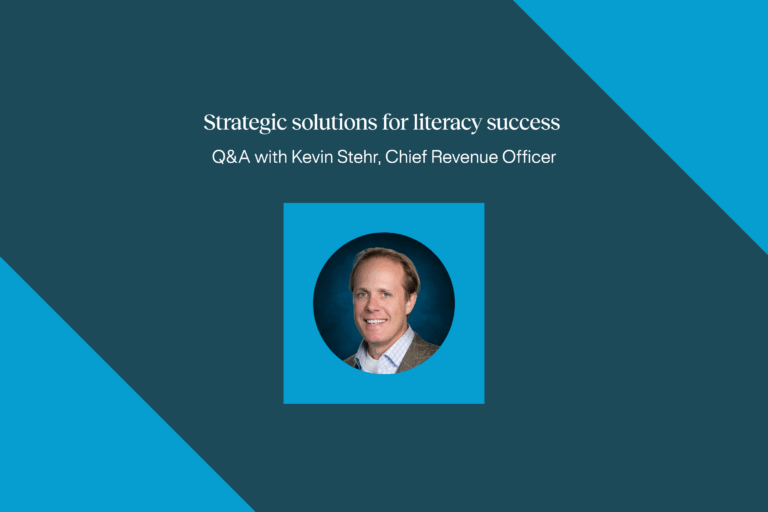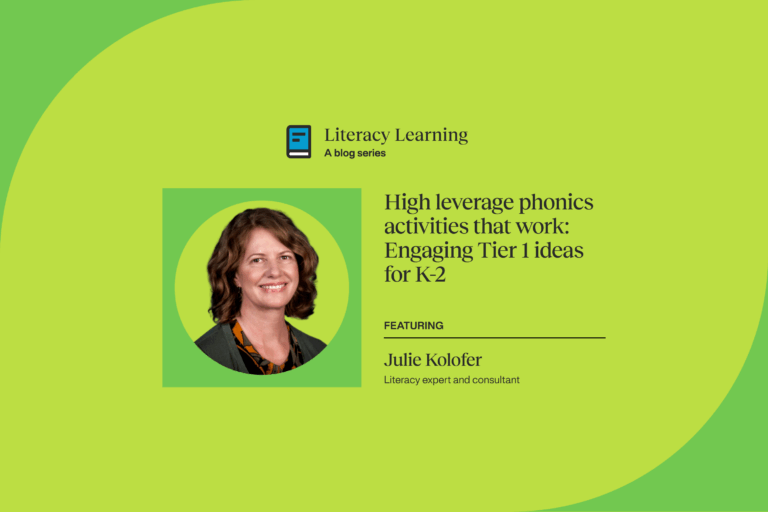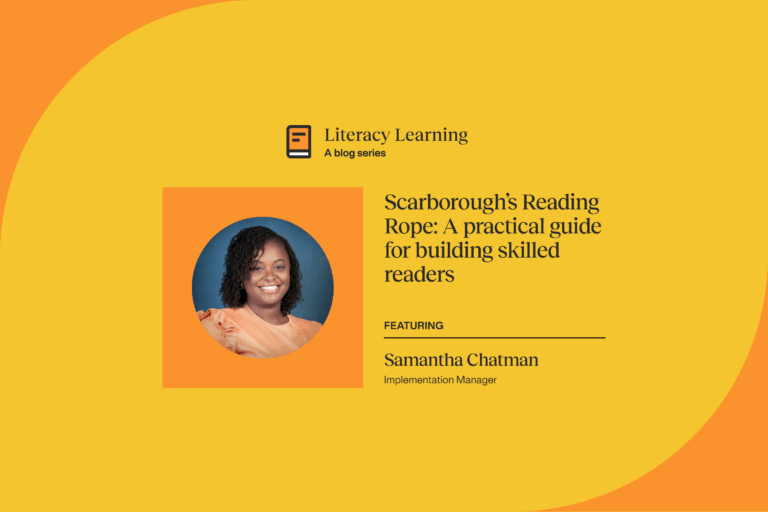A comprehensive guide to literacy assessment

According to the latest NAEP long-term trend assessment data, nine-year-olds had the largest score decline in reading¹ since 1990. The decline in basic reading skills especially impacted low-performers across racial/ethnic groups.
Literacy—the ability to create, consume, and critique different types of multimodal text—starts with building foundational reading skills and identifying instructional needs through literacy assessments.
The significance of literacy assessments
Literacy assessments are important because they help educators identify what students need to focus on so they can become stronger readers²—but they’re not one-size-fits-all. Each type of literacy assessment can broadly or specifically identify student skill gaps within reading. Some assessments end at that point while others provide further intervention opportunities. But it’s important to note too that assessments are not just about diagnosing skill gaps. They also help teachers identify students who need enrichment and extension intervention.
Types of literacy assessments
There are three common types of literacy assessments: Screening, diagnostics, and progress monitoring. The diagnostic reading assessments each have different goals and periods for evaluation.
Screening assessment
A screening assessment, also known as a universal screener, is a broader assessment that helps teachers identify students’ strengths and weaknesses. It also pinpoints those who are not meeting grade-level learning goals, checks for warning signs, and provides valuable insights to teachers so they can help struggling learners now or in the future.
From a school or district standpoint, a universal screener can confirm whether or not their literacy curriculum is effective in helping students understand the concepts.
How to apply screening assessments
A screening assessment is the critical first step in determining the scope of reading support needed by the school and is administered to the entire student population³ usually three times per year. According to the National Center for Improving Literacy (NSLI), the core elements of screening assessments should be brief, easy to administer, valid and reliable, and timely and informative.
Further examples of how to apply screening assessments include naming sounds in spoken words (phonemes) and sounds or names of letters in kindergarten and reading words in brief passages in first grade.
Examples of screening assessments
Well-known screening assessments include DIBELSⓇ and ACADIENCEⓇ. The DIBELSⓇ which means Dynamic Indicators of Basic Early Literacy Skills is used for students in kindergarten through eighth grade. The assessment was designed by researchers from the University of Oregon who started working on it in the 1980s. It became widely available to educators in the United States starting in 2002.
Meanwhile, ACADIENCEⓇ has multiple assessments including Acadience Reading Pre-K, Acadiene Reading K-6, and Acadience Reading 7-8, each made for the respective grade levels in the titles. ACADIENCEⓇ has further screeners including an Acadience Reading Diagnostic which can be used separately as a diagnostic assessment.
Diagnostic assessments
Diagnostic assessments identify specific areas where students are performing and provide more detailed information on where they need help. This type of assessment is usually not administered to the entire student population.
This type of assessment can be formal or informal and includes:
- Assessments that help pinpoint specific skill gaps
- End of unit tests to check for understanding
- Homework assignments
- Student work samples
- Once identified, the information is used to narrow down a targeted support or intervention to help the student improve.
How to administer diagnostic tests
Diagnostic assessments involve administering tests individually to students by reading teachers, special educators, speech and language pathologists, or school psychologists.
General examples include components of literacy subtests:
- Word recognition
- Decoding
- Reading comprehension
- Spoken and written language
Examples of diagnostic assessments
The Phonemic Awareness Screener for Intervention™ (PASI) is a diagnostic assessment that helps identify mastered and deficit phonological awareness skills. The goal of this assessment is to provide better gauges of students’ skills compared to DIBELSⓇ AIMSwebⓇ—and maps directly to Tier 2 and Tier 3 focused intervention instruction. These assessments are meant to be given directly by the classroom teachers.
Another example is the Phonics Screener for Intervention™ (PSI) which pinpoints the specific needs of students who have poor reading accuracy and/or fluency. This set of reading assessment tools identifies where to start each student’s intervention and how to move them onto another skill.
Progress monitoring
Progress monitoring is a type of formative assessment⁴ that confirms if the additional support or intervention is or is not successful. It also allows the educator to make changes at various points during the school year and determines if students can catch up to their peers. This type of assessment should be skill-based but sensitive enough to show growth over a short period. There are two types of progress monitoring:
- Mastery measurement: Evaluate performance on one specific skill to ensure mastery before moving onto the other
- General outcome measurement: Effective means of tracking progress throughout entire curriculum by evaluating frequently either through curricular sampling (every skill evaluated) or performance indicators (student scores indicate performance)
How to administer progress monitoring assessments
Progress monitoring occurs every 1-3 weeks. A general example includes weekly oral reading fluency tests to measure student reading progress throughout the entire year. This can include tracking the number of works students can correctly read per minute by doing timed repeated readings. The progress can be checked week-over-week to see how the student’s reading skills are improving.
Examples of progress monitoring assessments
For a specific example, the Phonological Awareness Screener for Intervention (PASI) includes one to two-minute progress monitoring after initial assessment and over 20 progress monitoring assessments per long-form document.
Understanding reading assessments
Effective assessments must identify student skill needs/gaps and diagnose the help they need. Two principles are standards and validity. For standards, literacy assessment must align with established state educational standards. It’s also important to clearly define learning objectives and outcomes to measure. Valid assessments⁵ produce data that can be used to inform education decisions like school effectiveness, teacher evaluation, and individual student performance and gains. It incorporates the assembling of evidence to support test score interpretation based on the desired measured construct. The ultimate goal is to determine if the assessment measures what it’s supposed to measure.
An example of a system that diagnoses and then uses data-informed grouping is the 95 Literacy Intervention System™. This digital platform combines phonics diagnostics with intervention data management and core intervention curriculum. It can automate grouping based on the educator’s desired parameters, consolidate progress measurement data across students, and simplify intervention planning from student skill proficiency data. This helps to ultimately minimize intervention dosages and deliver precise instruction to the right students at the right time.
Assessment methods
Assessments are completed in person through a physical assessment or digital format. Each assessment addresses components of a student’s ability to recognize sounds and letters, read accurately, and comprehend vocabulary and text passages.
Phonics and phonemic awareness assessments
A phonics assessment is a diagnostic tool that gauges a student’s ability to recognize letter sound patterns, as well as blend sounds together to decode words.
Phonemic awareness assessments measure the ability to hear and manipulate the sounds in spoken words. It also includes the understanding that spoken words and syllables are made up of sequences of speech sounds, or phonemes.
Strengths of phonics and phonemic awareness assessments
Phonics assessments help identify areas where a student may struggle such as decoding skills, letter-sound relationships, or blending sounds. An example of this are the pre-tests and end-of-unit assessments in the 95 Phonics Core ProgramⓇ . Additionally, phonics assessments like the 95 Phonics Screener for Intervention, helps to pinpoint the skills that each student has mastered and those that still need additional instruction. This assessment maps direction to phonics skill lessons in the 95 Phonics Lesson Library™—a Tier 2 intervention program that provides 75 evidence-based, fully prepared phonics lessons ranging from basic to advanced to multi-syllable skills.
Strengthening phonemic awareness skills is crucial for reading. Identifying these learning gaps early gives the student time to learn and catch up on their sound skills. Student assessment results can provide educators with opportunities to tailor their instructional strategies to those that target a student’s phonemic awareness weakness.
Both phonemic awareness and phonics assessment results can help tailor and guide adjustments to instruction to better meet the needs of students.
Weaknesses of phonics and phonemic awareness assessments
Phonemic awareness assessments does not provide a complete picture of a student’s overall reading abilities. For some phonemic awareness assessments, students whose primary language isn’t English may be affected—so it’s important to consider cultural contexts.
Phonics assessments narrow focus on isolated skills and could risk overlooking a student’s comprehension and language abilities. Generally speaking, administering phonics assessments may also take some time.
Oral reading fluency assessments
Oral reading fluency (ORF) assessments measure reading rate and accuracy. This is usually measured as words read correctly per minute. Three components of oral reading fluency are accuracy, rate, and expression.
Strengths of oral reading fluency
ORF can be smaller, quicker, and less expensive compared to major assessments⁶. It can also quickly determine results and catch children who are struggling to read. ORF is not restricted to school systems, so parents can also partake to fill in the gaps.
Weaknesses of oral reading fluency
Some weaknesses of ORF are it’s not comparable across countries or languages and can require significant resources and time. Some students have become adept at decoding words but because of the outsized capacity it takes for them to do so, they can’t attend to the meaning. This can be hard to pick up on from an ORF unless you are also employing a retell of the story. Additionally, its accessibility to everyone could run the risk of not administering the assessment correctly or coming to the wrong conclusions.
Vocabulary assessments
Vocabulary assessments are evaluations of a student’s knowledge of vocabulary words. This includes the size of their word knowledge, their ability to comprehend word meaning, and their capacity to use words effectively.
Strengths of vocabulary assessments
Vocabulary assessments can lay the groundwork for strengthening reading and writing skills and contribute to cognitive development by promoting memory, categorization, and word association. This assessment also gauges a student’s ability to communicate verbally and understand spoken language.
Weaknesses of vocabulary assessments
Weaknesses of vocabulary assessments include that it’s not representative of linguistic competence⁷ involved in everyday tasks. It’s also not representative of children’s true expressive language abilities, resulting in students not receiving proper intervention.
Comprehension assessments
A reading comprehension⁸ assessment asks a student to read a passage of text followed by detailed questions about the content of the text.
Strengths of comprehension assessments
Reading comprehension assessments can help identify specific areas of strength and weakness in a student’s comprehension. Ongoing assessments can serve as progress monitoring to further evaluate overall effectiveness, improvements, and areas that need additional support. These types of assessments also help students familiarize themselves with the types of questions they’ll encounter on standardized tests.
Weaknesses of comprehension assessments
One weakness of reading comprehension assessments is that they may not fully reflect a student’s ability to comprehend different genres or topics. This could be influenced by test-taking skills vs. actual comprehension—which can result in potentially incorporating cultural biases that could disadvantage students from diverse backgrounds.
Using assessments to improve literacy instruction
The role of literacy assessments is to provide teachers with information regarding the next steps in the learning progression⁹. Assessments are integral in informing educators on how to tailor their instruction while learning is in progress. Assessments can be formative or summative.
The goal of formative assessments¹⁰ is to monitor student learning and provide ongoing feedback. They’re usually lower-stakes assessments that help students identify their strengths, weaknesses, and additional areas of improvement. For educators, it helps them monitor the progress of student performance and continue to address learning gaps.
Summative assessments evaluate student learning at the end of instruction by comparing it against a benchmark. This is usually a higher-stakes assessment such as a standardized test.
The information from this type of assessment can guide educational efforts in courses that follow.
Success story: Arizona public school district
An Arizona school district needed to increase K–2 students’ phonic skills13 during summer school in summer 2021. This population scored the following on their Spring 2021 Acadience assessment:
- 20% tested below benchmark
- 48% tested well below benchmark
They used 95 Phonics Booster BundleⓇ: Summer School program and aimed to deliver approximately 20 of the lessons over the four-week program.
Students who engaged in the 95 Phonics Booster Bundle: Summer School literacy assessment tools achieved 163% higher gains in phonics skills. Additionally, there was a 122% increase in Acadience Reading scores for rising second graders who were well below benchmark.
Ultimately, the formative and summative assessments of the 95 Phonics Booster Bundle: Summer School program helped students with higher risks for reading failure narrow the gap in phonics deficits.
Final word
To summarize, literacy assessments are crucial in promoting literacy development since they help educators identify students’ strengths and weaknesses. Screening, diagnostics, and progress monitoring serve distinct purposes in providing valuable insights for tailored instruction. Together, phonemic awareness, phonics, oral reading fluency, vocabulary, and comprehension assessment methods can accurately provide a holistic picture of student reading skills. Literacy assessments—including formative and summative assessments—can further guide and enhance instructional decisions.
If you’re looking for effective assessments and intervention materials, 95 Percent Group assessments can help identify skill deficits, personalize student instruction, and provide whole class and small group learning to close skill gaps.
1: “NAEP Blog – Performance Declines in Basic Mathematics and Reading Skills since the COVID-19 Pandemic Are Evident across Many Racial/Ethnic Groups.” n.d. Nces.ed.gov. https://nces.ed.gov/nationsreportcard/blog/pandemic_performance_declines_across_racial_and_ethnic_groups.aspx.
2: “Literacy Assessment: Definitions, Principles, and Practices.” 2018. NCTE. October 25, 2018. https://ncte.org/statement/assessmentframingst/.
3: Renaissance, Michelle Hosp, Ph D. , Director of Foundational Literacy. 2023. “The Critical Role of Phonics Assessment in the Science of Reading – SPONSOR CONTENT.” Education Week, April 1, 2023, sec. Teaching & Learning, Reading & Literacy. https://www.edweek.org/sponsor/renaissance-learning/the-critical-role-of-phonics-assessment-in-the-science-of-reading#:~:text=A%20phonics%20assessment%20is%20an.
4: “Understanding Screening.” 2020. National Center on Improving Literacy. March 2, 2020. https://improvingliteracy.org/kit/understanding-screening.
5: Munger, Kristen A. 2016. “5. Types of Literacy Assessment: Principles, Procedures, and Applications.” Milnepublishing.geneseo.edu. Open SUNY Textbooks. 2016. https://milnepublishing.geneseo.edu/steps-to-success/chapter/5-types-of-literacy-assessment-principles-procedures-and-applications/.
6: Review of Progress Monitoring: Mastery Measurement vs. General Outcome Measurement. n.d. Iris Center . Peabody College of Vanderbilt University. Accessed December 11, 2023. https://iris.peabody.vanderbilt.edu/wp-content/uploads/modules/pmm/pdf/IRIS_PM_InfoBrief_011420.pdf#content.
7: The Center on Standards & Assessment Implementation. 2018. “Valid and Reliable Assessments CSAI Update.” https://files.eric.ed.gov/fulltext/ED588476.pdf.
8: “Understanding What Works in Oral Reading Assessments.” 2016. Uis.unesco.org. November 18, 2016. https://uis.unesco.org/en/blog/understanding-what-works-oral-reading-assessments.
9: “On the Limitations of Using Vocabulary Tests with School-Aged Students | Smart Speech Therapy.” 2018. Www.smartspeechtherapy.com. August 22, 2018. https://www.smartspeechtherapy.com/on-the-limitations-of-using-vocabulary-tests-with-school-aged-students/.
10: “Types of Informal Classroom-Based Assessment | Reading Rockets.” n.d. Www.readingrockets.org. https://www.readingrockets.org/topics/assessment-and-evaluation/articles/types-informal-classroom-based-assessment#:~:text=The%20typical%20type%20of%20reading.
11: “Literacy Assessment: Definitions, Principles, and Practices.” 2018. NCTE. October 25, 2018. https://ncte.org/statement/assessmentframingst/.
12: Carnegie Mellon University. 2020. “Formative vs Summative Assessment.” Www.cmu.edu. 2020. https://www.cmu.edu/teaching/assessment/basics/formative-summative.html#:~:text=The%20goal%20of%20formative%20assessment.
13: “Gains Study of 95 Phonics Booster Bundle.” n.d. Accessed December 11, 2023. https://live-www-nfpg.pantheonsite.io/wp-content/uploads/2023/03/95-Percent-Group_Booster-Bundle-Summer-School-Study-Results.pdf.



